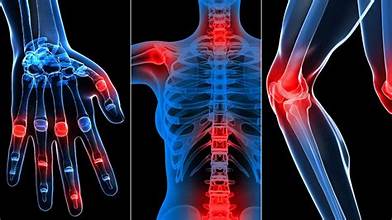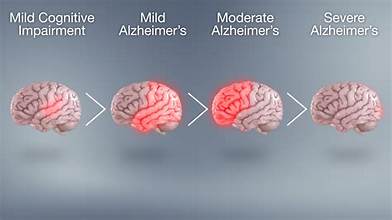What is Arthritis?
Arthritis is a condition that damages the joints the points where two bones connect. As people age, it’s common for some joints to wear down naturally, which can lead to arthritis over time. In other cases, arthritis may develop after an injury or as a result of certain medical conditions.
This disease can affect any joint in the body but most often occurs in the:
- Hands and wrists
- Knees
- Hips
- Feet and ankles
- Shoulders
- Lower back (lumbar spine)
A healthcare professional can help manage arthritis symptoms such as pain, swelling, and stiffness. In severe cases, surgery may be needed to replace the damaged joint.
You should see a healthcare provider if joint pain interferes with your daily activities or if you notice difficulty moving your joints as you normally do.
Types of Arthritis:
There are over 100 different types of arthritis, each affecting the body in unique ways. Below are some of the most common forms:
1. Osteoarthritis (OA):
Known as “wear-and-tear” arthritis, osteoarthritis occurs when the protective cartilage that cushions the ends of the bones gradually wears down over time. It typically affects weight-bearing joints such as the knees, hips, and spine, but it can also impact the hands and fingers. Symptoms often include joint pain, stiffness, and reduced flexibility.
2. Rheumatoid Arthritis (RA):
Rheumatoid arthritis is an autoimmune disorder where the immune system mistakenly attacks the lining of the joints (synovium). This causes inflammation, pain, swelling, and can eventually lead to joint deformity or bone erosion. RA often affects multiple joints at once—commonly in the hands, wrists, and knees and may also cause fatigue or fever.
3. Gout:
Gout develops when excess uric acid in the blood forms sharp, needle-like crystals that deposit in the joints, causing sudden and severe pain, swelling, redness, and warmth. It most often affects the big toe but can also occur in the ankles, knees, and fingers. Gout attacks can be triggered by certain foods, alcohol, or dehydration.
What Causes Arthritis?
The exact cause of many forms of arthritis is still not fully understood. However, researchers believe that a combination of genetic, environmental, and lifestyle factors plays a major role in its development.
Several factors can increase your risk of developing arthritis, including:
- Age: As people grow older, the protective cartilage between joints naturally wears down. This makes arthritis especially osteoarthritis more common with advancing age.
- Gender: Women are more likely than men to develop most types of arthritis, such as rheumatoid arthritis and lupus, while gout tends to affect men more often.
- Genetics: Some forms of arthritis run in families. If your parents or siblings have conditions like rheumatoid arthritis, ankylosing spondylitis, or psoriatic arthritis, your risk may be higher due to inherited genes.
- Excess Weight: Carrying extra body weight puts additional pressure on weight-bearing joints, such as the knees, hips, and spine, leading to faster cartilage breakdown and a greater risk of osteoarthritis.
- Joint Injuries: Previous injuries such as fractures, dislocations, or ligament tears can damage joints and make them more prone to developing arthritis later in life.
- Infections: Certain bacterial, viral, or fungal infections can invade joints, causing inflammation and sometimes leading to chronic arthritis.
- Occupation: Jobs that involve repetitive joint movement, kneeling, squatting, or heavy lifting can strain the joints and increase the likelihood of arthritis, particularly osteoarthritis.
- Autoimmune Disorders: In autoimmune types of arthritis, such as rheumatoid arthritis or psoriatic arthritis, the immune system mistakenly attacks healthy joint tissues, leading to chronic inflammation and pain.
- Metabolic Issues: Conditions like gout develop when uric acid builds up in the body and forms sharp crystals in the joints, triggering sudden and severe pain.
- Smoking and Alcohol Use: Smoking can worsen inflammation and increase the risk of autoimmune arthritis, while excessive alcohol intake can raise uric acid levels and contribute to gout.
- Poor Nutrition: Diets lacking in vitamins, antioxidants, and omega-3 fatty acids may contribute to inflammation, while high intake of processed or sugary foods can also increase risk.
4. Ankylosing Spondylitis (AS):
Ankylosing spondylitis is a chronic inflammatory arthritis that primarily affects the spine and the joints near the lower back. Over time, it can cause the vertebrae to fuse, leading to stiffness and a reduced range of motion. It can also cause pain in the hips, shoulders, and neck, and sometimes affects the eyes or other organs.
5. Psoriatic Arthritis (PsA):
This type of arthritis affects some people who have psoriasis a skin condition that causes red, scaly patches. Psoriatic arthritis can cause joint pain, swelling, and stiffness, often in the fingers and toes. It can also lead to nail changes and, in severe cases, joint damage if not treated early.
6. Juvenile Arthritis (JA):
Juvenile arthritis refers to several types of arthritis that affect children and teenagers under the age of 16. It can cause joint pain, swelling, fatigue, and growth problems. The condition may be temporary or chronic, and its exact cause is not fully understood, though it is believed to involve immune system dysfunction.
Depending on the type, arthritis can lead to joint degeneration (breakdown of cartilage and tissue) or inflammation, and in many cases, both occur together. Early diagnosis and proper management are key to reducing pain, preserving joint function, and improving quality of life.
What Are the Symptoms and Signs of Arthritis?
Arthritis symptoms can vary depending on the specific type and the joints affected, but most forms share common signs related to joint inflammation and damage. These symptoms may develop gradually or appear suddenly, and their severity can range from mild discomfort to disabling pain.
Common symptoms and signs of arthritis include:
- Joint pain: Persistent or intermittent pain is one of the most noticeable symptoms. The pain may worsen after activity or long periods of rest.
- Stiffness: Many people experience stiffness, especially in the morning or after sitting still for a while, making it difficult to move the joints freely.
- Swelling: Inflammation can cause joints to become swollen, puffy, or appear larger than normal.
- Warmth and redness: The skin around the affected joints may feel warm to the touch or look reddish, indicating active inflammation.
- Tenderness: Joints often become sensitive or painful when pressure is applied.
- Reduced range of motion: Movement in the affected joint may become limited, making it harder to perform daily activities.
- Fatigue: Chronic inflammation can cause overall tiredness and lack of energy.
- Muscle weakness: Muscles surrounding inflamed joints may weaken over time due to reduced use or pain.
- Joint deformity: In long-term or severe cases, chronic inflammation can cause joints to lose their normal shape or alignment.
- Grinding or clicking sounds: Some people may notice cracking or grating noises (crepitus) when moving their joints, often due to cartilage wear.
The location and pattern of these symptoms depend on the type of arthritis:
- Osteoarthritis usually affects the knees, hips, spine, or hands.
- Rheumatoid arthritis tends to involve the smaller joints, such as those in the hands, wrists, and feet, often on both sides of the body.
- Gout commonly causes sudden, severe pain in the big toe or other joints.
- Psoriatic arthritis may affect joints and also cause skin and nail changes.
Some types of arthritis cause symptoms that come and go in flare-ups, where pain and swelling suddenly worsen, followed by periods of relief. Others lead to constant pain and stiffness, especially after physical activity or rest.
If you experience persistent joint pain, stiffness, or swelling that lasts for more than a few weeks, it’s important to see a healthcare provider for proper evaluation and early treatment to help manage symptoms and prevent joint damage.
Complications of Arthritis:
When arthritis becomes severe or left untreated, it can lead to several complications that affect both physical function and overall quality of life. The condition doesn’t just cause pain—it can also damage joints permanently and impact other areas of the body.
Here are some of the major complications linked to arthritis:
- Limited mobility: Severe joint pain and stiffness can make everyday tasks such as dressing, cooking, or writing difficult, especially if the hands, wrists, or arms are affected.
- Reduced physical activity: Pain and discomfort often discourage movement, which can lead to muscle weakness, joint stiffness, and loss of flexibility over time.
- Joint deformity: Chronic inflammation can cause permanent changes in joint structure, leading to visible deformities or misalignment.
- Loss of independence: As arthritis progresses, it may interfere with a person’s ability to perform basic activities without help, affecting self-care and independence.
- Chronic pain and fatigue: Ongoing joint pain and inflammation can lead to persistent tiredness, sleep disturbances, and reduced energy levels.
- Emotional and mental strain: Living with chronic pain can cause anxiety, stress, or depression, impacting mental well-being and social life.
- Bone erosion and cartilage loss: In inflammatory types such as rheumatoid arthritis, the immune system attacks joint tissues, gradually eroding bone and cartilage, which can lead to permanent disability if not treated early.
- Balance and posture problems: Arthritis in weight-bearing joints like the hips, knees, or spine can make walking, climbing stairs, or even sitting up straight painful and unstable, increasing the risk of falls.
- Systemic complications: Certain types of arthritis, such as rheumatoid or psoriatic arthritis, can also affect internal organs like the heart, lungs, or eyes, leading to additional health issues.
- Reduced quality of life: Persistent pain, limited motion, and fatigue can significantly affect work performance, hobbies, and overall life satisfaction.
What Age Does Arthritis Usually Begin?
Arthritis can occur at any age, depending on its type and underlying cause. While it’s often associated with older adults, even young people and children can develop certain forms of the disease.
- Osteoarthritis (OA): This is the most common form of arthritis and typically develops in adults over the age of 50. It results from gradual wear and tear on the joints over time, although younger adults may also experience it after joint injuries or repetitive strain.
- Rheumatoid Arthritis (RA): RA is an autoimmune condition that most often appears between the ages of 30 and 60, but it can occur earlier or later. Women are more likely to develop it than men.
- Juvenile Arthritis: Some types of arthritis, such as juvenile idiopathic arthritis, can appear in children and teenagers, causing joint pain, swelling, and stiffness.
- Post-Traumatic Arthritis: This form can develop after a joint injury, such as a fracture, dislocation, or ligament tear, regardless of age. Symptoms might not appear until years afterthe initial injury.
- Gout: Gout tends to occur in adults, particularly men over 40 and postmenopausal women, once uric acid levels remain elevated for a long period.
- Ankylosing Spondylitis: This inflammatory arthritis often begins in late adolescence or early adulthood, typically affecting the lower spine and hips.
In short, arthritis doesn’t have a set age of onset it depends on the type, genetic factors, lifestyle, and joint health. If you experience persistent joint pain, stiffness, or swelling at any age, it’s best to speak with a healthcare professional to identify the cause early and prevent complications.
How Is Arthritis Diagnosed?
Getting an accurate diagnosis is the first and most important step in managing arthritis. Since the condition includes many different types, your doctor will use several methods to determine which form you have and how severe it is.
Here’s how arthritis is typically diagnosed:
- Medical History: Your healthcare provider will begin by reviewing your personal and family medical history. They’ll ask about your symptoms such as when they started, which joints are affected, and how severe the pain or stiffness is as well as any previous injuries or health conditions.
- Physical Examination: During the exam, your doctor will inspect and feel your joints for signs of swelling, redness, warmth, tenderness, or limited movement. They may also check for muscle strength, joint stability, and any deformities.
- Imaging Tests:
- X-rays are commonly used to identify changes in the joints, such as loss of cartilage, bone spurs, or joint space narrowing, which are often seen in osteoarthritis.
- MRI (Magnetic Resonance Imaging) and ultrasound scans can provide more detailed images of soft tissues, cartilage, and early signs of inflammation that may not appear on X-rays.
- Joint Fluid Analysis (Arthrocentesis): Your doctor may remove a small amount of fluid from the affected joint using a needle. This fluid is tested for inflammation, infection, or uric acid crystals, helping distinguish between types like gout, infectious arthritis, or osteoarthritis.
- Blood and Urine Tests:
These tests can help detect markers of inflammation or specific antibodies linked to certain types of arthritis. For example:- The Rheumatoid Factor (RF) test checks for antibodies often found in people with rheumatoid arthritis, although it can appear in other diseases as well. The Anti-Cyclic Citrullinated Peptide (anti-CCP) test is more specific for rheumatoid arthritis and can help predict more aggressive or advanced disease.
- Additional blood tests may check for C-reactive protein (CRP) and erythrocyte sedimentation rate (ESR), both of which measure inflammation levels in the body.
- Infectious Arthritis Testing: If your doctor suspects an infection as the cause, analyzing the joint fluid or running cultures can help identify the bacteria, virus, or fungus responsible, guiding proper treatment.
Through a combination of your medical history, physical exam findings, lab work, and imaging results, your doctor can make a precise diagnosis and design a personalized treatment plan to manage symptoms and protect joint function.
Arthritis Treatment and Management:
The main goal of arthritis treatment is to relieve pain, improve joint function and mobility, reduce inflammation, and slow disease progression. Because arthritis varies by type and severity, treatment plans are often personalized and may combine several approaches for the best results.
Here are the common methods used to manage arthritis:
- Medications:
- Doctors may prescribe different types of medicines to control pain and inflammation, depending on the type of arthritis. These can include:
- Pain relievers (analgesics): Such as acetaminophen or prescription painkillers. Nonsteroidal anti-inflammatory drugs (NSAIDs): Like ibuprofen or naproxen, to reduce swelling and stiffness .Corticosteroids: Used to quickly decrease inflammation and immune activity. Disease-modifying anti rheumatic drugs (DMARDs): Commonly prescribed for autoimmune types like rheumatoid arthritis to slow joint damage.
- Physical and Occupational Therapy:
Working with a therapist can help improve flexibility, muscle strength, and joint stability. Therapists may also teach safe ways to perform daily tasks and recommend assistive devices to reduce strain on joints. - Lifestyle Modifications:
Maintaining a healthy weight, eating an anti-inflammatory diet, and doing low-impact exercises like swimming, walking, or yoga can help reduce pressure on joints and improve mobility. - Hot and Cold Therapy:
Applying warm compresses can relax stiff joints and muscles, while cold packs can help reduce swelling and numb pain. - Rest and Joint Protection:
Balancing activity with rest is essential to prevent overuse and joint damage. Using braces, splints, or supportive footwear can also protect joints during movement. - Surgical Options:
When other treatments don’t provide relief, surgery may be considered. Procedures can include joint repair, replacement (such as hip or knee replacement), or joint fusion to restore function and reduce pain.
With early diagnosis and proper management, many people with arthritis can maintain an active and fulfilling lifestyle. Modern treatments especially for autoimmune types like rheumatoid arthritis can now slow or even halt disease progression, offering much better long-term outcomes than in the past.









